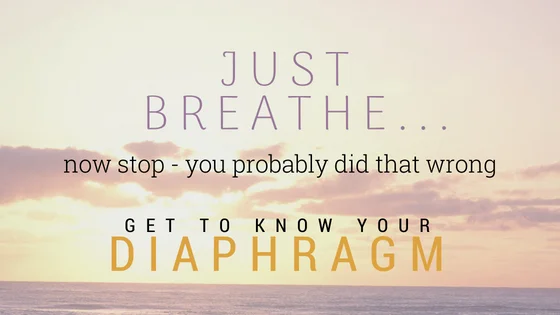Just breathe... Now stop - you probably did that wrong. Get to know your diaphragm.
Most people never think much about how they breathe. In fact, breathing is an automatic process, meaning we literally don't have to think about it for it to happen on its own. The surprising thing is, the vast majority of people out there breathe in a way that is incredibly inefficient. This is thought to be caused by long hours spent sitting and slouching over, like in office jobs, where the abdomen has restricted movement.
Many people breathe by lifting their shoulder and chest to inhale and letting them fall to exhale. This is called clavicular breathing, as in the clavicle or collar bone. The problem with clavicular breathing is you are only taking in at best maybe half of your total lung capacity, and you have to exert a lot of effort to do so. By inhaling with your chest and shoulders, you are ignoring the main muscle that nature built especially for breathing: the diaphragm.
The diaphragm is a muscle that sits at the bottom of your ribcage and has sort of a dome shape. It separates your thoracic cavity, containing your ribcage, lungs, and heart, from your viscera (guts) underneath. While the diaphragm is technically a voluntary muscle, it is still difficult to feel and control on its own. Instead, we will control it indirectly by relaxing our lower abdominals.
Now's not the time to be shy, let your belly hang out. Don't push it out - put your hand on your belly below your belly button and allow those muscles to relax and your belly sort of falls out under its own weight.
When your diaphragm contracts it flattens out and lowers, creating more space in your thoracic cavity as well as your lungs. Your ribcage also expands outwards a bit. As your lungs expand, there is extra room inside, creating a partial vacuum and sucking in air from the outside. The lowering of the diaphragm also pushes all of your guts down and outward to make room, thus the belly expansion. Gross, I know.
Your diaphragm cannot move down if your abs are tense! You must relax your lower abdominals to allow your belly to move outwards.
When you exhale, your diaphragm relaxes and returns to its dome shape, while the lower abdominals engage and push the air up and out from the bottom up, sort of like squeezing a toothpaste tube. Your ribcage should remain expanded and buoyant until the end of your exhalation.
Practice breathing in and out a few times. Begin by relaxing your lower abdominals, letting your belly move outwards while you take in a deep breath. Imagine the breath filling your torso all the way from the bottom up (even though you don't have any lungs down there). Make sure your shoulders do not move upwards, they should remain low and relaxed. After your belly moves out and you start to near the top of your inhalation, allow your ribcage to open up and expand around the circumference, especially the sides, but do not lift your shoulders!
When you are ready to exhale, put one hand below your belly button and one hand on your chest over your sternum. Make 4 short, sharp hisses followed by one long one, like "ss ss ss ss sssss". The hand on your belly should be bouncing in and out, and you may feel your chest bulge out a small amount opposite of your abs on each hiss. This shows how your abdominals work to push the air out of your lungs while you are singing. Your abdominals must be relaxed and flexible to provide this kind of expansion and support.
If you are still having trouble feeling how your belly should move in and out, or your shoulders keep lifting, try lying down on the floor on your back. Keep your shoulders low and pressed against the floor, this should prevent them from moving. Put your hand below your belly button and feel it moving up and down with your breath. Practice this a few times then try and recreate the feeling standing up.
I hope you enjoyed this article. Thank you for reading and be sure to subscribe to be notified of new blog posts. Till next time!
~Alexander

